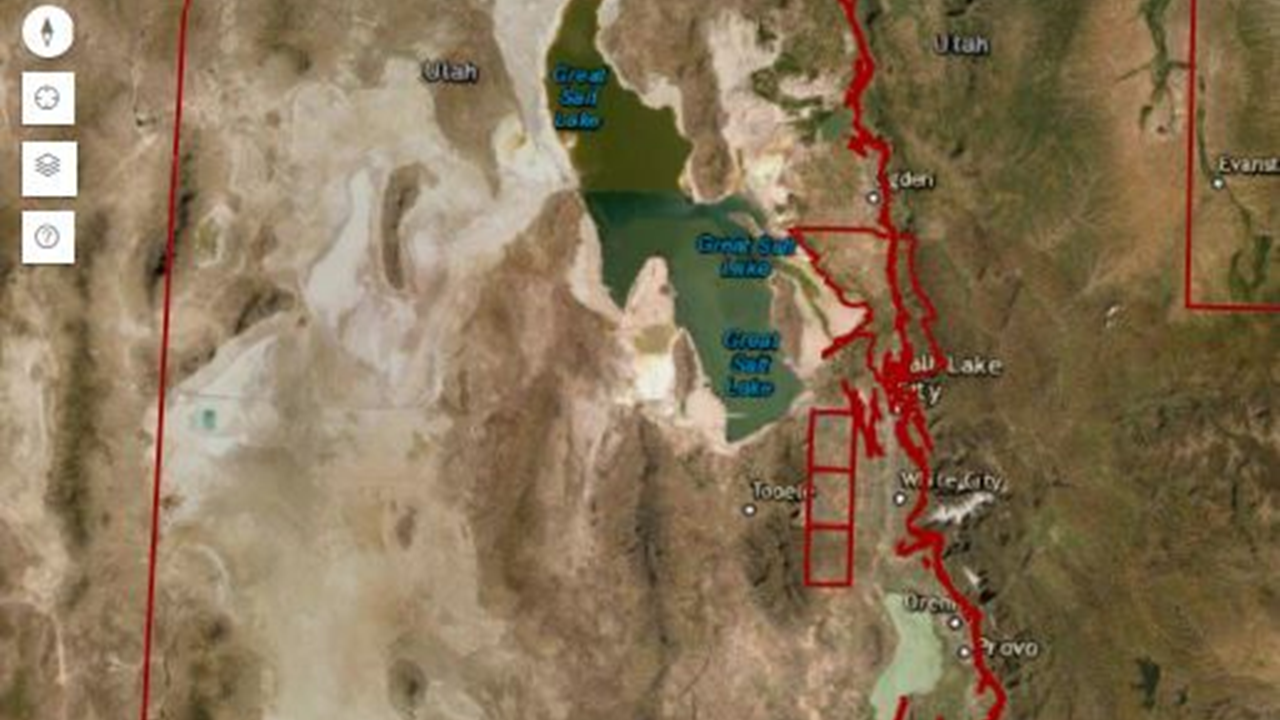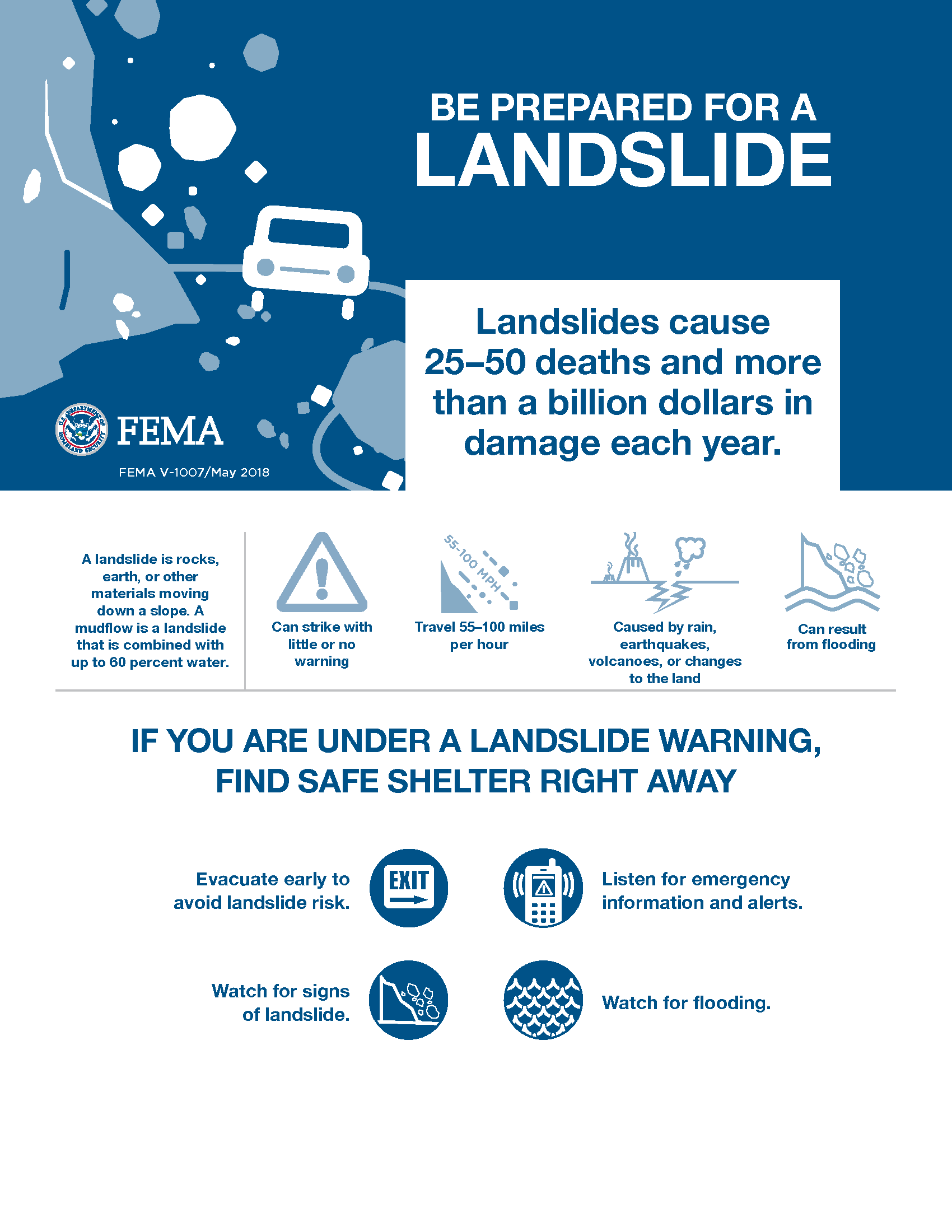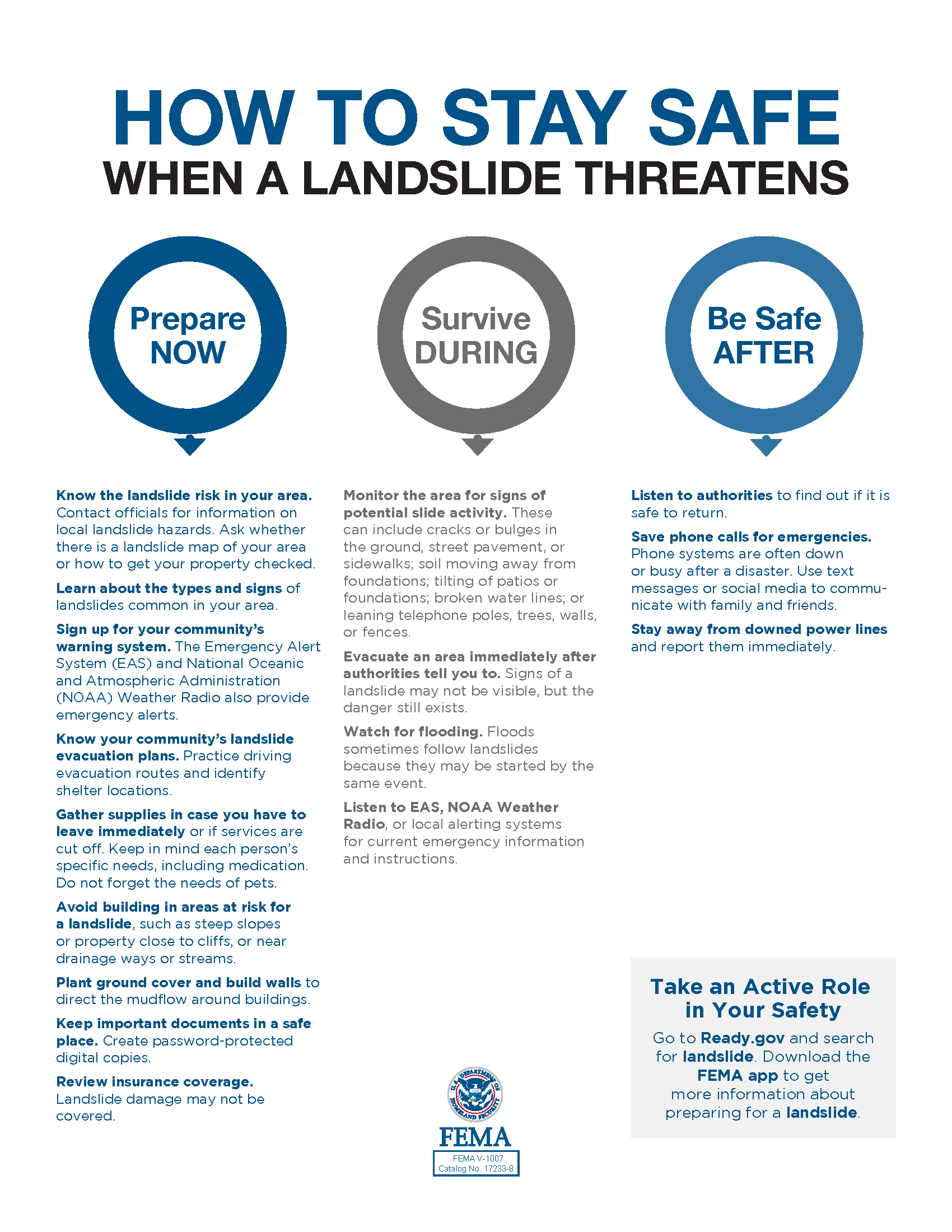Landslide
THE POINT
DO THIS
- Know the precursor signs of land movement.
- Find out if your at risk through the Utah Geologic Hazards Portal interactive map.
- Do the actions to reduce the chances of a landslide.
- Make an evacuation plan.
Protective Action: Evacuate
VIDEOS
- The Most Expensive Landslide in US History - Thistle, UT
- Time Laps Video Shows Landslide Crush a Home
- Eaglepointe Landslide Flyover, North Salt Lake
- Massive Landslide Buries Road in Central Utah
- Zion Rockfall Caught on Video
- Bingham Canyon Mine Landslide
- Hildale Responders Tribute 2015
- Hildale Flood Area Flyover
- Two People Killed After Rock Slide Flattens Utah Home
- (58 min movie) Riding the Storm "Landslide Danger in the San Francisco Bay Area
- What is a Debris Flow?
- 2003 Debris Flow in Devore CA
- USGS - Landslide Hazards
- USGS - Landsides and Debris Flows Playlist
DOWNLOADS
What's Your Landslide Risk?
The Utah Geologic Hazards Portal has an interactive map of earthquake, liquefaction, landslide, radon, and other risks near you.
Utah Geologic Hazards Portal
Landslides
Landslides have occurred in almost every state and can cause significant damage. The term landslide describes downhill earth movements that can move slowly and cause damage gradually, or move rapidly, destroying property and taking lives suddenly and unexpectedly. Most landslides are caused by natural forces or events, such as heavy rain and snowmelt, shaking due to earthquakes, volcanic eruptions and gravity. Landslides are typically associated with periods of heavy rainfall or rapid snowmelt and tend to worsen the effects of flooding. Areas burned by forest and brush fires are also particularly susceptible to landslides.
Landslides generally happen in areas where they have occurred in the past. Learn about your area’s landslide risk. Landslides can also be referred to as mudslides, debris flows, mudflows or debris avalanches.
Debris flows and other landslides onto roadways are common during rainstorms.
Heavily saturated ground is very susceptible to mudflows and debris flows.
Be aware that, generally, landslide insurance is not available, but that debris flow damage may be covered by flood insurance policies from the National Flood Insurance Program (NFIP) at www.FloodSmart.gov.
Know the Signs
- Cracks in soil
- Tilted or bent trees
- Increased spring activity or newly wet ground
- Hummocky or uneven terrain
- Sagging or taut utility lines
- Sunken or broken road beds
- Movement of soil away from foundations
- Leaking or broken water pipes
- The presence of a previous landslide is one of the biggest and most obvious risk factors.
If you suspect active landslide movement, evacuate and contact your local fire, police, emergency manager, or public works department.
What is Your Risk?
Find out if you live in an area that is at risk for landslides by visiting the Utah Geologic Hazards Portal which has an Interactive map of earthquake, liquefaction, landslide, radon, and other risks near you.
Before
You and your neighbors share more than fences. You all share the responsibility of keeping your slopes safe. There are actions you can take as a homeowner to reduce the chances of a landslide affecting your property:
DO
- Drain water from surface runoff, downspouts, and driveways well away from slopes
- Plant native ground cover on slopes
- Consult with a professional before significantly altering existing slopes uphill or downslope of your home
- If you suspect you are on a landslide, contact a licensed engineering geologist or a geotechnical engineer for an evaluation
- Check online maps, such as Utah Geological Hazards Portal to see if you might live in a landslide area
DO NOT
- Do not add water to steep slopes
- Avoid placing fill soil on or near steep slopes
- Avoid placing yard waste or debris on steep slopes
- Avoid excavating on or at the base of steep slopes
Look for warning signs on your property
If you live on or near a steep slope, evaluate your property for signs of landslide movement. Many (but not all) signs of landslide activity are listed below. A high score may indicate the presence of a landslide.
Inside Your Home
- Cracks in walls
- Nails popping out of walls
- Bulging walls
- Separation of chimney from walls
- Creaking/popping noises
- Light switches coming out of walls
- Doors/windows hard to shut
- Twisted beams
- Cracks in floors
- Water seeping into basement
Outside Your Home
- Changes in surface drainage
- Bulges in retaining walls or tilting of walls
- Cracks developing in the soil
- Pistol-butted or bent trees
- Broken water, utility, or sewer lines
- Cracks in sidewalks or foundation
- Stretched or leaning utility lines
Consult a professional before purchasing a property in sloping areas.
What should I do if I live in an area at risk from landslides or mudslides?
-
Learn about local emergency response and evacuation plans.
-
Talk to everyone in your household about what to do if a landslide occurs.
-
Create and practice an evacuation plan for your family and your business.
-
Assemble and maintain an emergency preparedness kit.
-
Become familiar with the land around where you live and work so that you understand your risk in different situations.
-
Watch the patterns of storm water drainage on slopes near your home, especially where runoff water converges.
During
What should I do if a landslide or mudslide is occurring or likely to occur?
-
If you suspect imminent danger, evacuate immediately. Inform affected neighbors if you can, and contact your public works, fire or police department.
-
Listen for unusual sounds that might indicate moving debris, such as trees cracking or boulders knocking together.
-
If you are near a stream or channel, be alert for any sudden increase or decrease in water flow and notice whether the water changes from clear to muddy. Such changes may mean there is debris flow activity upstream so be prepared to move quickly.
-
Be especially alert when driving— watch for collapsed pavement, mud, fallen rocks and other indications of possible debris flow.
-
If you are ordered or decide to evacuate, take your animals with you.
-
Consider a precautionary evacuation of large or numerous animals as soon as you are aware of impending danger.
During Severe Storms
-
Stay alert and awake. Many deaths from landslides occur while people are sleeping.
-
Listen to local news stations on a battery-powered radio for warnings of heavy rainfall.
-
Consider leaving if it is safe to do so.
After
What should I do after a landslide or mudslide?
-
Stay away from the slide area. There may be danger of additional slides.
-
Check for injured and trapped persons near the slide, without entering the direct slide area. Direct rescuers to their locations.
-
Help a neighbor who may require special assistance--infants, elderly people, and people with disabilities. Elderly people and people with disabilities may require additional assistance. People who care for them or who have large families may need additional assistance in emergency situations.
-
Listen to local radio or television stations for the latest emergency information.
-
Watch for flooding, which may occur after a landslide or debris flow. Floods sometimes follow landslides and debris flows because they may both be started by the same event.
-
Look for and report broken utility lines to appropriate authorities. Reporting potential hazards will get the utilities turned off as quickly as possible, preventing further hazard and injury.
-
Check the building foundation, chimney, and surrounding land for damage. Damage to foundations, chimneys, or surrounding land may help you assess the safety of the area.
-
Replant damaged ground as soon as possible since erosion caused by loss of ground cover can lead to flash flooding.
-
Seek the advice of a geotechnical expert for evaluating landslide hazards or designing corrective techniques to reduce landslide risk. A professional will be able to advise you of the best ways to prevent or reduce landslide risk, without creating further hazard.



